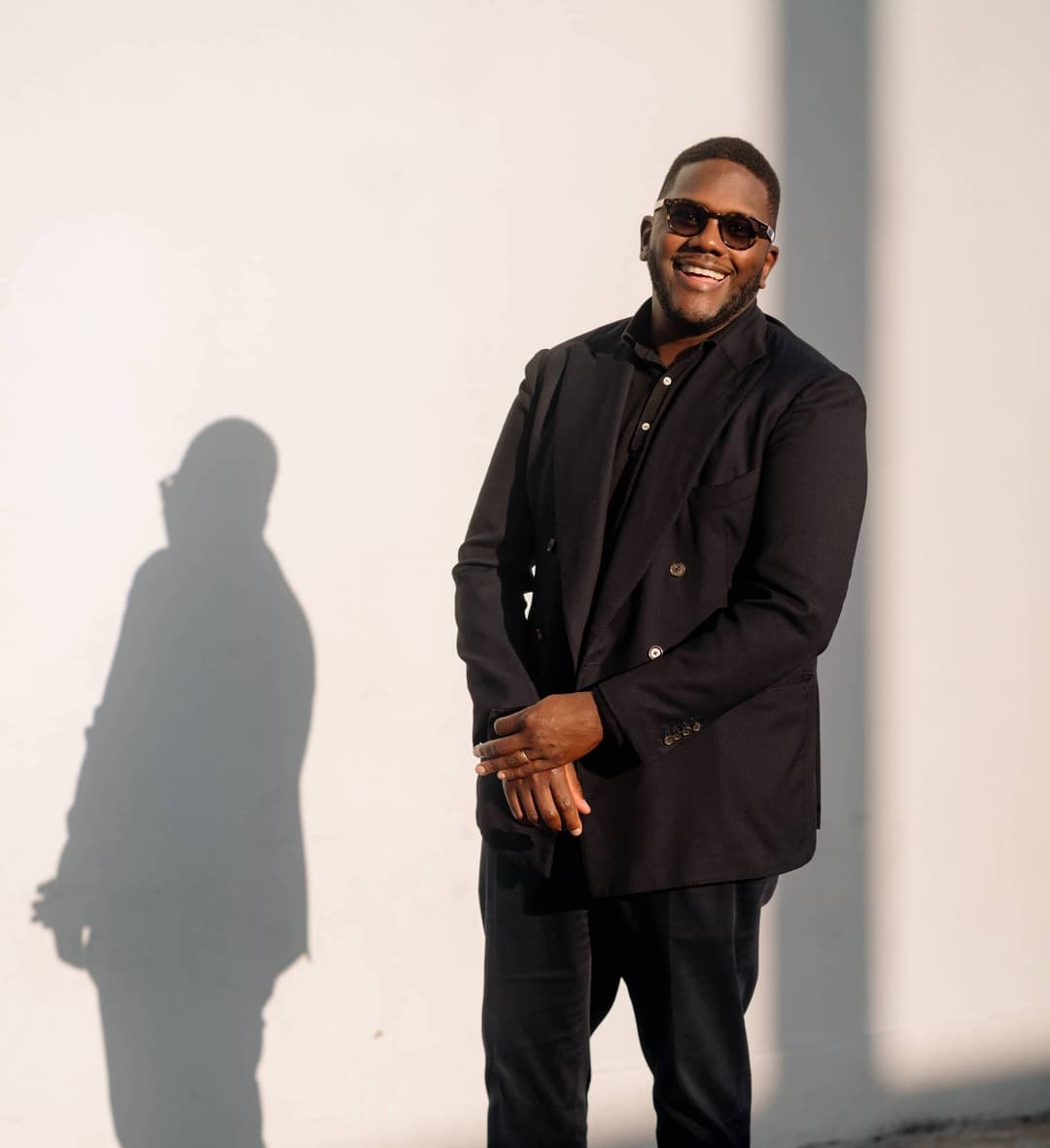
Alan Dones
Strategic Urban Development Alliance
Alan Dones, Managing Partner and Co-founder of the Strategic Urban Development Alliance (SUDA), has spent his career breaking barriers across multiple industries. Today, he and a cohort of like-minded leaders are managing some of the largest developments in the Bay Area, each with the potential to revitalize the region and create huge numbers of new jobs and exciting new opportunities for its communities.
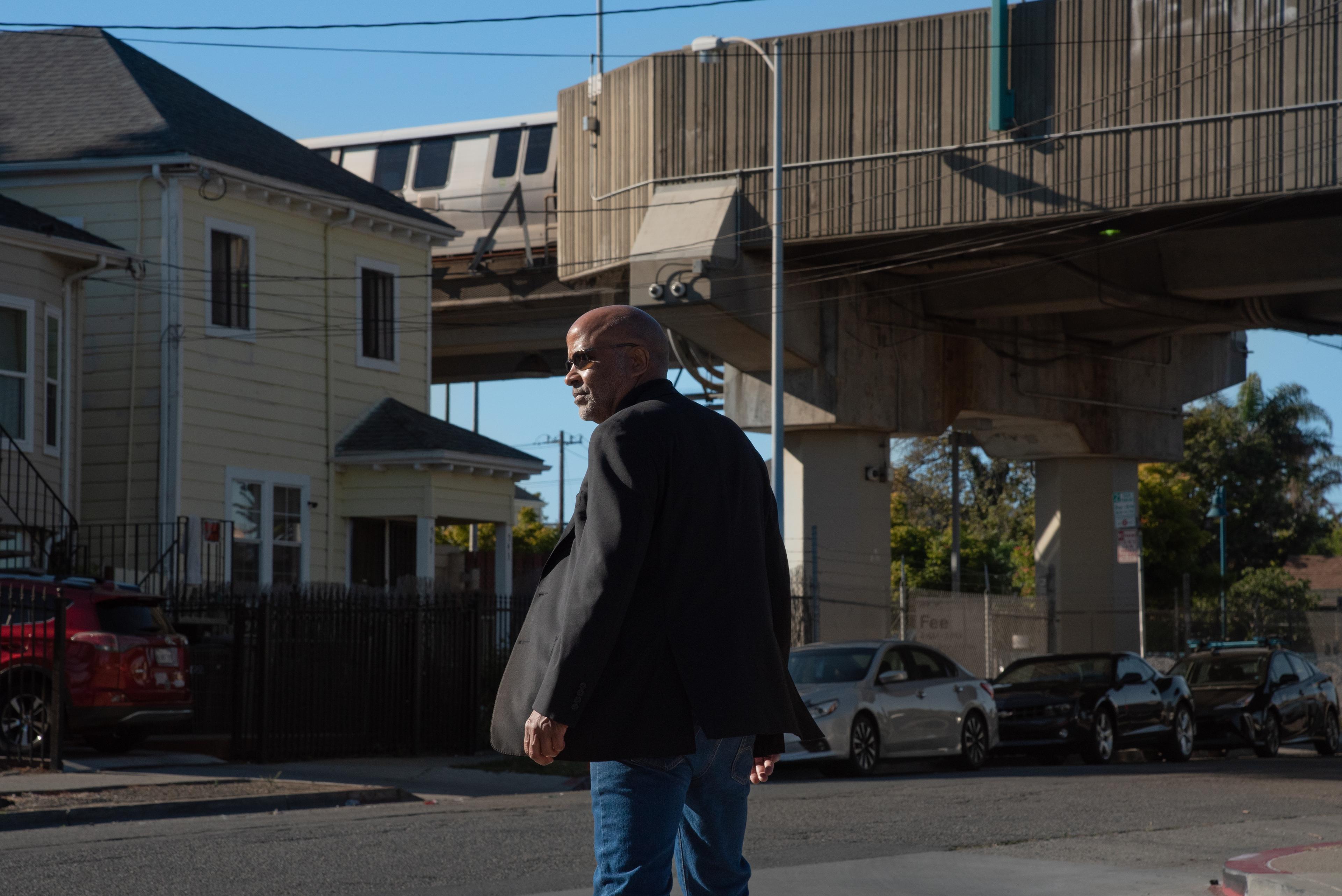
By Ximena Natera for Commonplace
Could you start us off by introducing yourself and your work?
My name is Alan Dones and I'm the Managing Partner of Strategic Urban Development Alliance (SUDA). We're a small development team based here in Oakland, California and we work primarily on large-scale developments that involve some form of public-private partnership.
One of the things that we’re most proud of at SUDA is that the projects we go after and do are big relative to the size of our company. We’re able to operate at this level because we’re great at assembling teams of capable consultants, collaborators, and strategic partners to implement massive, transformative projects. We also make it a point to innovate across many different facets of development, including site acquisition and assemblage, marketing, financing, and construction, both in terms of the materials we use and the techniques we employ. These strengths are what enable us to stay lean and mean and make an outsize impact on Oakland and our local communities.
Right now, our three main projects are the West Oakland Bay Area Rapid Transit (BART) Station Development, also known as Mandela Station, which is fully entitled; the Eastline project, which is another transit-oriented development; and the Oakland Coliseum project, which is in the earliest stages of planning. All of these are projects on public land owned by the City of Oakland, BART, or, in the case of the Coliseum project, jointly owned by the City and Alameda County. Collectively, they represent about $20 billion in development value.
Can you share some details about your personal background?
I was born in Oakland, but I grew up, and went to school, in El Cerrito, where my dad, who was a contractor, built our family home. Back in the day, it was very challenging for African Americans to find land to build a house on or buy property outright because many lots had restrictive easements that essentially barred anyone who was not white from purchasing the property. My dad was fortunate enough to find a little street in El Cerrito without these and built our house there along with a few other houses for other African American families in the area. However, I also spent a lot of time in West Oakland because my dad’s businesses were there, my mom taught for 38 years at West Oakland Elementary School, and my grandfather was a pastor of a church there, so I was always going back and forth.
At the time, Oakland was a hotbed of cutting edge thinking in terms of social activism and the arts, as well as in science and technology. It was a very open environment, right upon on the edge of the Pacific Rim, at a time when there was an increasing awareness of social issues. Groups like the Black Panthers were active, the National Association of Minority Contractors had just been founded, the Urban League had expanded, and the UC Berkeley Free Speech Movement was going strong.
On the technology side, there was a lot of innovation happening in the Bay and I was able to get some exposure to that as well because, although my dad was a contractor and developer, he was also an inventor whose interests included audio engineering. He developed these big innovations in music and sound – such as the first patent for the subwoofer component of a stereo system – and worked with the likes of Meyer Sound and Dolby and as well as many different musicians and music industry folks. So growing up there were all sorts of big name people in music, sports, and other fields around my family all the time.
There was always something happening in the East Bay and it was really cool growing up in such an innovative and vibrant cultural environment.

Alan Dones at his home in Oakland, CA
By Ximena Natera for Commonplace
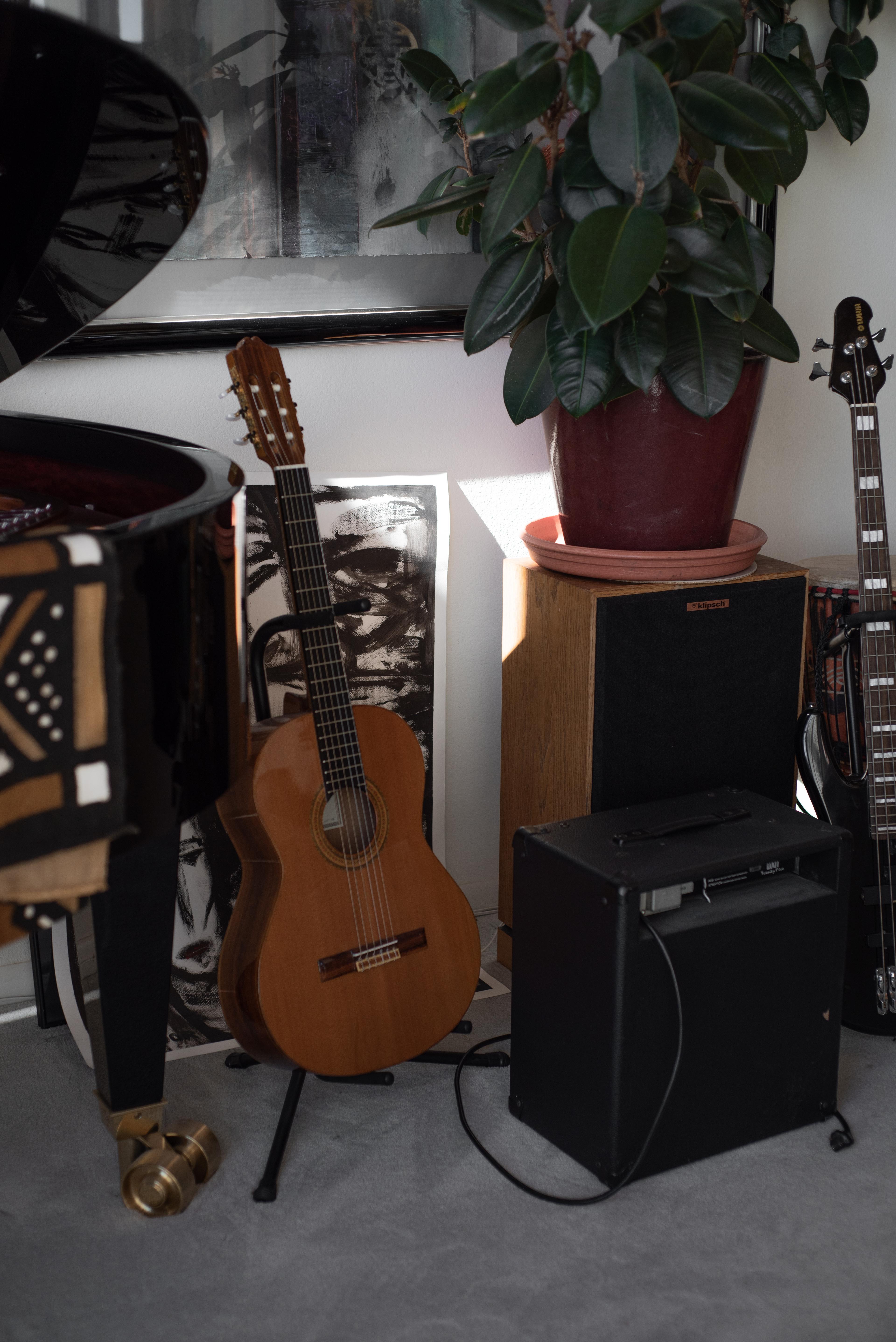
Alan spent years in the music industry and is an accomplished musician and producer
By Ximena Natera for Commonplace
Can you tell us a bit about your career path and how you got to where you are today?
I'm kind of an unusual developer in that I came up through the trades. I studied business at San Jose State University and I spent some of my earlier years in the music industry, but primarily I spent a lot of my time as a journeyman electrician after going through an apprenticeship program. My dad had a pretty major electrical and general contracting company known as Trans-Bay Engineering and Builders and much of my career was about putting me on a trajectory to integrate into the family business and keep that going.
However, I never did end up working much for my family. Working in the trades, I was never really satisfied with the working conditions and opportunities that were afforded to me and other tradespeople of color. I was always looking for ways to claw my way up the totem pole, so that I could have more control over my circumstances and use that control to create better working conditions and opportunities for myself and for others. I ended up studying construction management and eventually got my General Engineering and General Building Contractor's licenses in the state of California.
From there, I continued to climb up the food chain, relying on innovation and technology to set my businesses apart – because I didn’t think affirmative action or other such policies were enough to effectively address the disparities in the industry. With that approach, I started making a name for myself in public sector contracting and development and eventually, around ‘99 and 2000, I started to lean more into the development side. There was a bit of a ramp up as we tried different approaches; for example, early on we built affordable housing in Richmond using modular technologies that were just starting to hit the market. But eventually we started looking at bigger public-private developments.
The first significant development project we did was Thomas Berkley Square, a $91 million dollar mixed-use development in Downtown Oakland, which was basically the first crane up in that neighborhood in 38 years. While we were still figuring out what to do with our lots, we learned that the County of Alameda had been trying for 11 years to build a new headquarters and services center for its Department of Social Services (DPSS), but were running into problems every time they tried to get it built as a traditional public works development project.
That’s where SUDA came in and, long story short, we got the assignment to build a 110,000 square foot mixed-use building, which included space for DPSS. Instead of doing it the traditional way, where you would build a stand-alone public building with a big parking lot around it, we decided to build it as part of a mixed-use development in the core of Downtown Oakland. We used the County’s space as the anchor for the project and also built housing, commercial office, and retail space around the government office building. We also took a pretty innovative approach to financing, which allowed us to float $51 million of low-cost tax-exempt bonds as opposed to just traditional equity and debt. It was actually one of the first projects to ever take on that kind of structure in Northern California and it was a feat of financial engineering as much as it was civil engineering.
We turned the turn-key office space over to the County in 2005 and the second phase of the project was completed in 2008. We’ve continued with that focus on large public-private developments ever since.
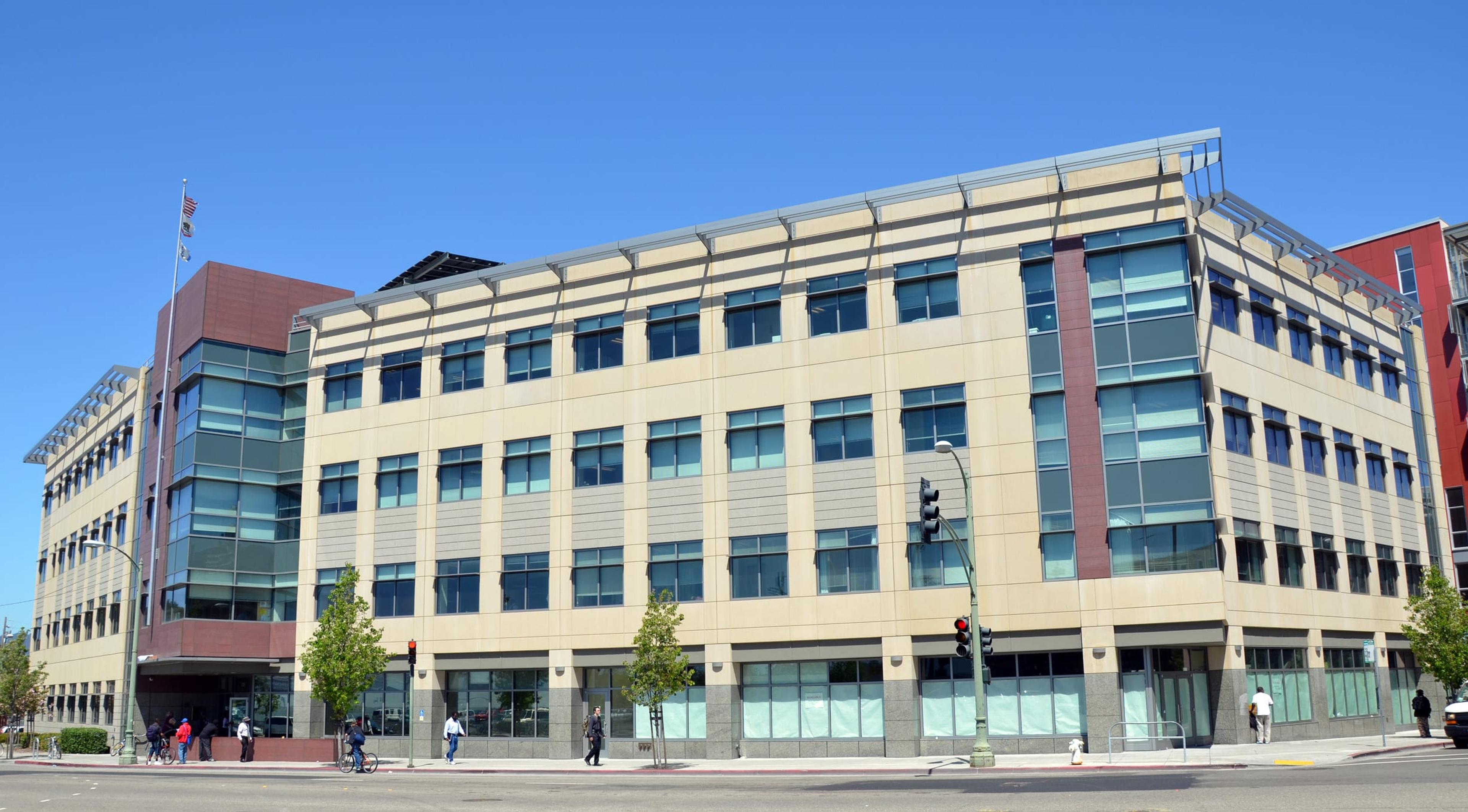
The county office at Thomas Berkley Square
Courtesy of SUDA
You mentioned that you relied on innovation and technology to compete and that there were significant disparities in the industry. Can you elaborate on that and give some examples of the innovations that you're referring to?
Our innovations span a number of areas, including finance and procurement, as well as construction means and methods. One great example is a technology my construction company introduced to the public works industry for underground pipe repair. It was an innovative new approach supported by our intellectual property that allowed us to repair major sanitary or storm drain sewers without needing to dig up the street; and it was so successful that it ultimately evolved into a multi-billion dollar industry for non-invasive infrastructure repair. We were able to win competitive bids on the merits of our products and pricing – and that’s what I did for pretty much all of the 90s, performing about $70 million of that construction business all around the country.
However, sooner or later barriers to entry start to catch up. Many of the neighborhoods and cities I was working in had literally zero African American contractors in public works and infrastructure. So when I emerged as a Black GC taking the world by storm and winning all the public contracts, I’m sure I upset established local firms. Unfortunately, these firms also had long-standing personal relationships with the people writing the public contracts and checks and suddenly I started having a hard time getting payments and having my requests for information and change orders reviewed in a timely manner. Initially, it had been pretty fluid, but eventually I was facing this problem in many different cities across the country. It got to a point where we had millions of dollars of payments delayed for work that we’d successfully performed.
I started to realize that some of the barriers I was facing had nothing to do with whether or not I had the best product for the job. Quite frankly, public works construction is a big industry with many different philosophical beliefs. Unfortunately, when some public administration officials would encounter me as a Black contractor performing public contracts, they’d assume that I was only there because I got a sweetheart deal or benefitted from affirmative action programs, despite my competitive, winning bids. It's hard enough being a contractor and running a business efficiently, but when you add the weight of those racial biases, it becomes a real challenge.
The situation was untenable and, hindsight being 20/20, I probably would have been better off accepting some of the offers I had received to acquire my intellectual property. It was the idealist in me who wanted to stay in and represent my people in the industry. But I learned it wasn’t enough to fight for my place; I also had to be realistic and think carefully about how to get around these bias-driven challenges. Following that train of thought, I decided to get into development as a way to put myself in a position to write the checks, hire contractors like myself to do the job, and thereby generally have a lot more control over my circumstances as the sponsor of a project.
"I will say that times are changing, but they are changing slowly and we’ve still got a long way to go. To get there, we all need to embrace our roles as changemakers and contribute incrementally in making that progress toward a better world."

By Ximena Natera for Commonplace
How many and what kinds of projects have you completed to date?
In terms of projects completed, honestly, not that many, but that’s not to say I haven’t been active. I’ve done three significant lease-leaseback projects with the Oakland Unified School District to date, where they leased their property to us and we turned it back over after construction completion. Those are some of the smaller, quicker projects we’ve been on and there are a number of other similar projects that we have completed as well.
However, as I mentioned earlier, we've been designated for three major development opportunities in the city and have mainly been focusing our energy on those. The thing is that these kinds of projects all have long, long gestation periods. My friend Mike Ghielmetti at Signature Development has a similar project, Brooklyn Basin, and every time I get a bit dejected and frustrated with our pace, I just think about how it took him 13 years to break ground from the time he got his contract approved by the City. However, his project is truly awesome, even just looking at what's being constructed so far, and there’s much more to come.
"Projects of this scale take time, but they’re also not projects that are likely to be torn down anytime soon. These are going to be here probably for a century or two at least, which puts the 10 to 20 years it takes to put the projects together and get them built in a different perspective – I don't think the Empire State Building is going to be torn down anytime soon, you know?"
Got it. And of those completed projects, can you highlight one in particular and dig a bit deeper into it? How was your emphasis on innovation and technology reflected in the project?
I’ll talk more about Thomas Berkley Square because it’s the first of our larger projects and it embraced innovation and technology in a way that I think really defines our approach to development. It was also significant in that it was an early mover in Downtown Oakland that helped kickstart a whole wave of development in the area.
As I mentioned, this was a mixed-use project anchored by County office space that was built using $51 million of low-cost tax-exempt bond financing. That was a game changer because in a traditional deal I would have needed $20 million in equity and if we couldn’t get that, then I would’ve had to turn over control to somebody who not only didn’t look like me, but also probably didn’t share my views of equity and inclusion. The other benefit is that we were able to leverage the pre-emptive land use authority of the public agency to get our entitlements in record time, which was a huge help in getting the project done on time and on budget. This was a relatively untested approach at the time, and I believe our success contributed to a growing awareness of how public-private development works.
On the construction side, there were a number of unique challenges that we had to solve for. To start, our lease with the County required us to keep the on-site parking fully functional for the duration of the construction of the 91 residential units to be built on top. So we had to initially design for and construct 150 ground-level parking stalls in a way that would allow us to later add additional parking and the condo units – and do so without disrupting operations and access to those parking stalls.
In terms of technology, the project was the first to deploy the ConXtech system in Oakland, which let us quickly pop structural beams in place rather than welding and bolting them in. That allowed us to put the superstructure up in six weeks when the average at the time was around 18 weeks using the traditional approach; I still remember we would have busloads of engineers and architects come by the site just to watch us implement this new system. Besides the structure, we also used a unique pre-assembled skin for the façade that was easy to install, durable, and low maintenance. Being such early adopters of new technology required design innovation and a lot of engineering, but ultimately our hard work paid off and we were able to build quickly and efficiently.
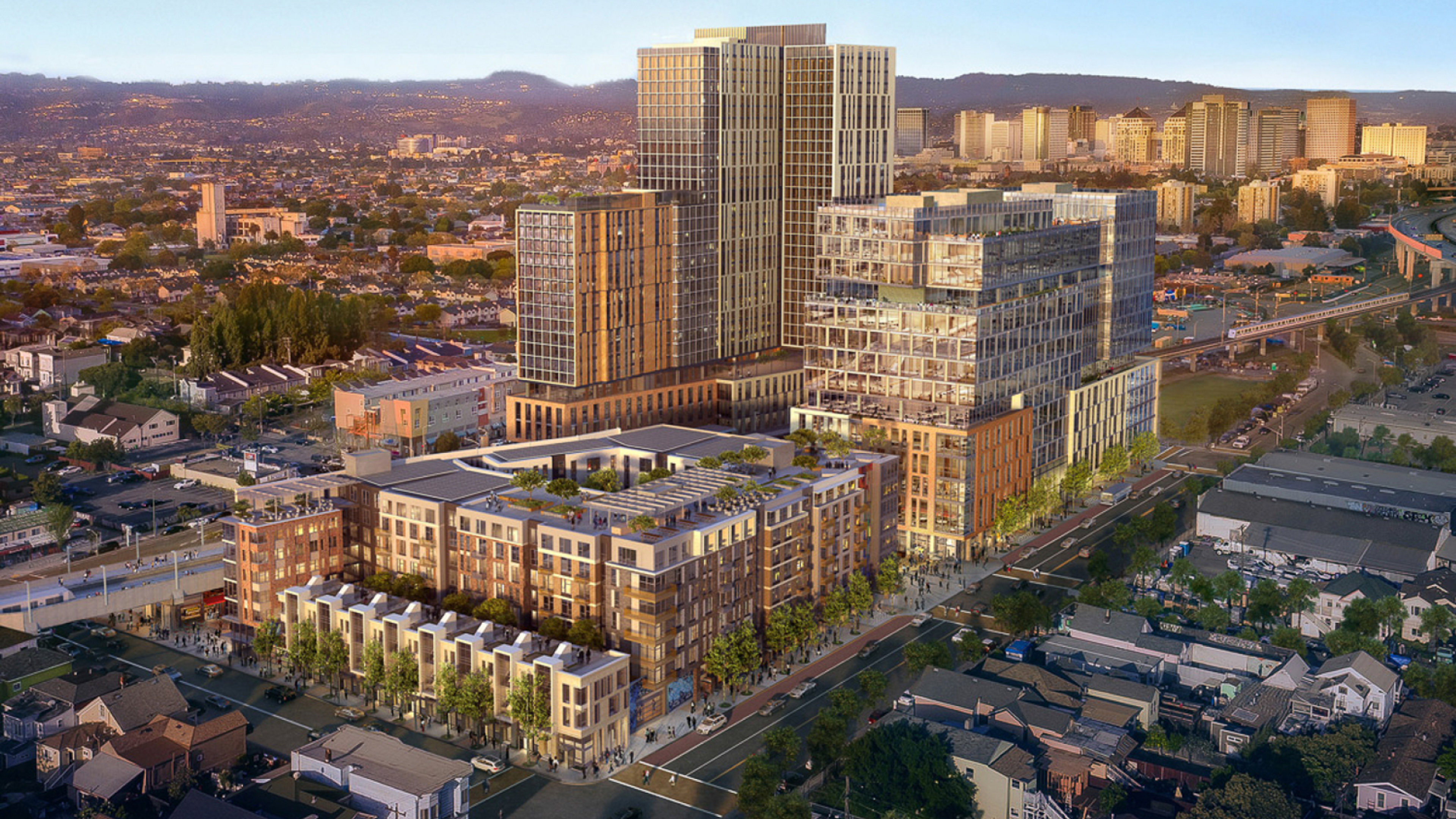
An aerial rendering of Mandela Station
Courtesy of SUDA
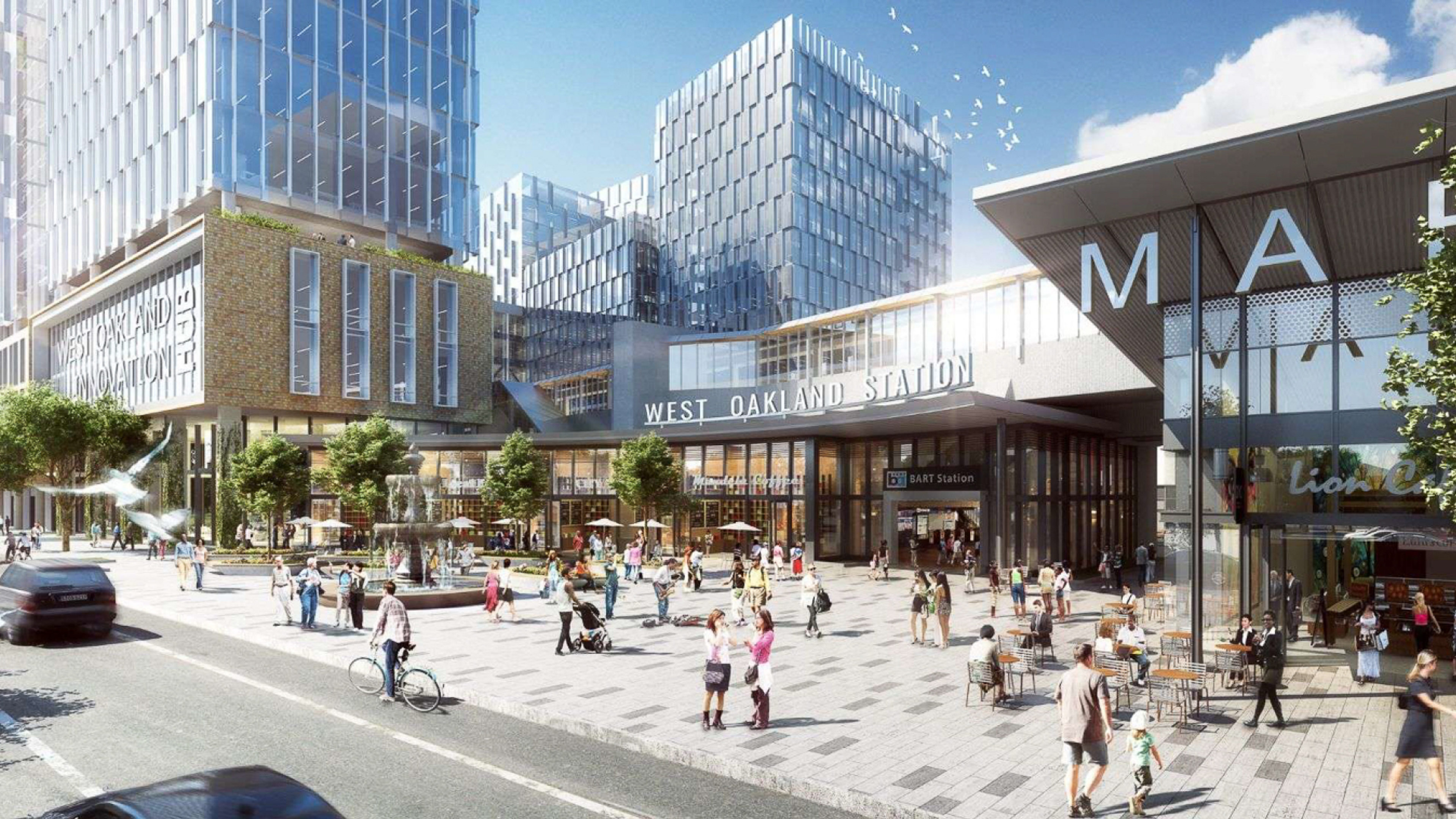
A rendering of the West Oakland BART Station
Courtesy of SUDA
Turning now to your pipeline, you mentioned there are three major development opportunities that you’re working on. Of the three, which are you most excited about and why?
I would say that all of them are exciting, but I’ll share more about Mandela Station because it’s the project we consider to be the tip of the spear; it’s already fully entitled and will be the first of our current portfolio to break ground. We’ve been working hard on this for about six or seven years now and we expect it’ll be another seven to ten years until the whole thing is completed. But when it’s done, it’ll have 760 residential units – 520 market rate and 240 affordable – 300,000 square feet of office and life sciences space, and 53,000 square feet of ground floor retail with a total budget of around $900 million across all the different phases.
However, it won’t be easy. Mandela Station is a challenging site; it’s in an underdeveloped neighborhood with a lot of homeless camps and a number of other challenges that we’ll have to overcome. We do have a few things going for us though. First, as I mentioned, we’re already fully approved and entitled; it cost us about $10 million in pre-development costs to get to this point, but it’s pretty significant progress. Second, this is a project that has major public support; for example, we have the community’s approval to build a 320-foot tower on the site, which is over three times the maximum height allowed by as-of-right zoning regulations. And with that support has come significant public funding. A few weeks ago, we made headlines because our Governor, Gavin Newsom, awarded the City with a $10 million grant, of which $8 million is for Mandela Station. That’s on top of the roughly $110 million of grant funding commitments we already have in place, which really shows you how much of a lightning rod this is for the stakeholders in the area. That said, most of the current funding is for the affordable housing piece, which is about $230 million of the total budget; we just need to fill a gap of about $7 million to get that going.
The office component is trickier since we're in a very challenging economic cycle for real estate in the Bay Area right now, but we believe that what is ultimately going to get that office space underwritable is innovation. For context, Mandela Station is being built on top of the West Oakland BART Station – actually, all of our projects are on BART stations – and BART has been making some significant capital improvements over the past few years. Part of that includes installing new cable trays and conduits to expand the existing fiber optic network that runs throughout BART’s 131 miles of right-of-way. They’re also installing a new 34.5 kilovolt redundant power supply to supplement the existing power supply, which is still serviceable, but becoming a bit outdated. That combination of potential uninterrupted power and exceptional connectivity differentiates our Mandela Station project by creating some really interesting technology use cases.
Typically, data centers are huge structures built cheaply and far from commercial centers; that makes it cost effective, but you get some latency. That can be a little annoying sometimes, but it’s generally not life threatening. On the other hand, there are very specific uses that are dependent on high speed and reliable connectivity. One is autonomous vehicle infrastructure. Self-driving vehicles need to stay in constant communication with a command center and other vehicles on the road – a few milliseconds can be the difference between a near miss and a major accident. Another case is in big data, where analysis of large data sets – like what’s produced by the Large Hadron Collider or extremely high-resolution telescopes – is hindered by the need to send that data off to a cloud server. That has led to the emergence of edge computing, which uses localized data centers to perform initial data reviews before sending off the most relevant or interesting data to the cloud for further supercomputer-driven analysis. A lot of the cutting-edge research of the future will be dependent on edge computing, which has applications in numerous fields, like life sciences, public administration, and disaster response to name just a few.
By creating a home for these emerging technologies at Mandela Station – the only BART station in the East Bay with access to every other line – we will be able to create a West Oakland Innovation Center that will attract innovative new companies to the area. That will create excellent jobs for this historically underinvested community, including jobs that don’t necessarily require a college degree.
Having such a strong focus on technology and innovation is rather uncommon for developers. What makes you so comfortable with incorporating new and relatively untested technology in your work?
There are competitors out there who are highly armed with resources that give them the ability to easily knock me out of my seat. So it's never a given that I'm going to be able to hold on and get anything done, but just sitting back and complaining about being under-resourced is not acceptable to me. I need to respond with a winning strategy – and embracing technology is one approach that has helped me compete despite my disadvantages.
"It's not that I’m so much more comfortable than others with technology, it’s that I’m more uncomfortable with being excluded from the real estate industry altogether. I’ve basically exchanged the discomfort of exclusion for the discomfort of introducing innovative strategies and technologies that aren’t industry norms or really in anybody's playbook."
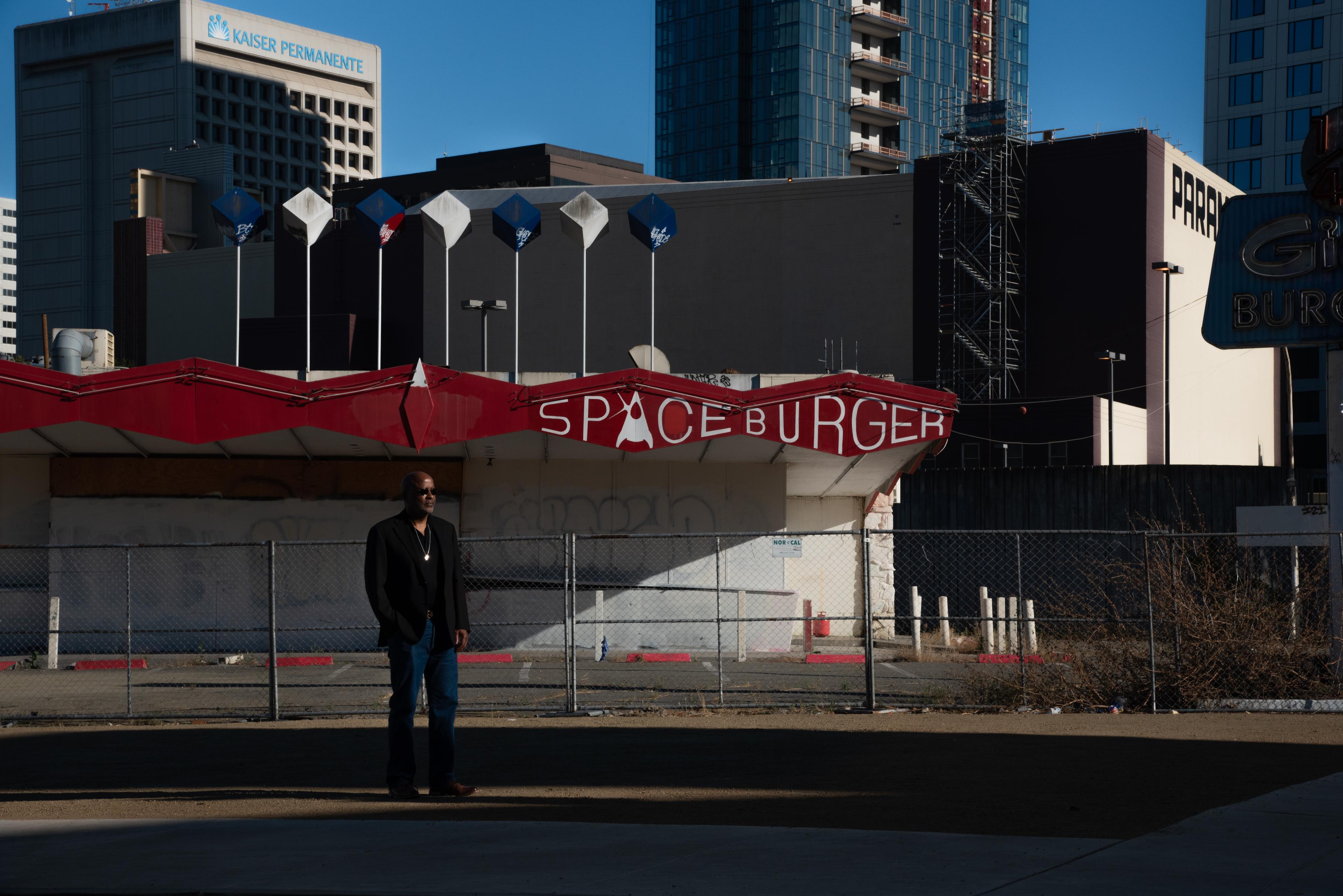
A street view of the Eastline project site
By Ximena Natera for Commonplace
Where are your other projects in terms of progress and what do you need to get them to the same state of readiness?
Generally speaking, we have all the usual challenges you face navigating pre-development, so I’ll focus on the Coliseum project as it’s the biggest opportunity in our pipeline and also the most unique in its needs. To give you some background, we’re the development partner in a JV that has the exclusive negotiating rights for the City’s 50% interest in the site; the other 50% is held by the County of Alameda. The project site involves a subdivision that will have 20 development parcels with a collective FAR of potentially over 16 million square feet.
The tricky part in implementing that plan is that the Oakland A’s recently announced that they’re moving to Las Vegas. That occurred despite the fact that the County of Alameda previously sold its 50% ownership stake of the site with the primary objective of keeping the A’s in Oakland. Now that they are joining the Warriors and the Raiders in leaving the city, there’s an intense need and passion to move on, though what exactly that will look like is still being discussed. In any case, there are probably still major professional sports franchises in our future, as the sports economics in the East Bay are still among the best in the country. As such, offsetting the departures of those three teams is a priority. However, this time around, the City is going to be a little smarter. They see now that those teams came and made tons of money using venues constructed with our public funds, then left as soon as they were offered big bucks, walking away from Oakland with billions in net value gains.
With that lesson learned, the focus will be on bringing economic development to the city in a way that is more equitable and inclusive; and our job is to promote that perspective and find and welcome the many potential partners out there who share our ethos and vision. With 20 parcels, there are effectively 20 opportunities for people to contribute to a brighter future for Oakland, either by coming into the deal individually or by stepping in at the earlier stage and being part of the big lift. It’s an amazing opportunity and it’s important for everyone, not just us, because these are really our community’s projects too.

One of the proposed visions for the Oakland Coliseum
Source: City of Oakland Coliseum Area Specific Plan
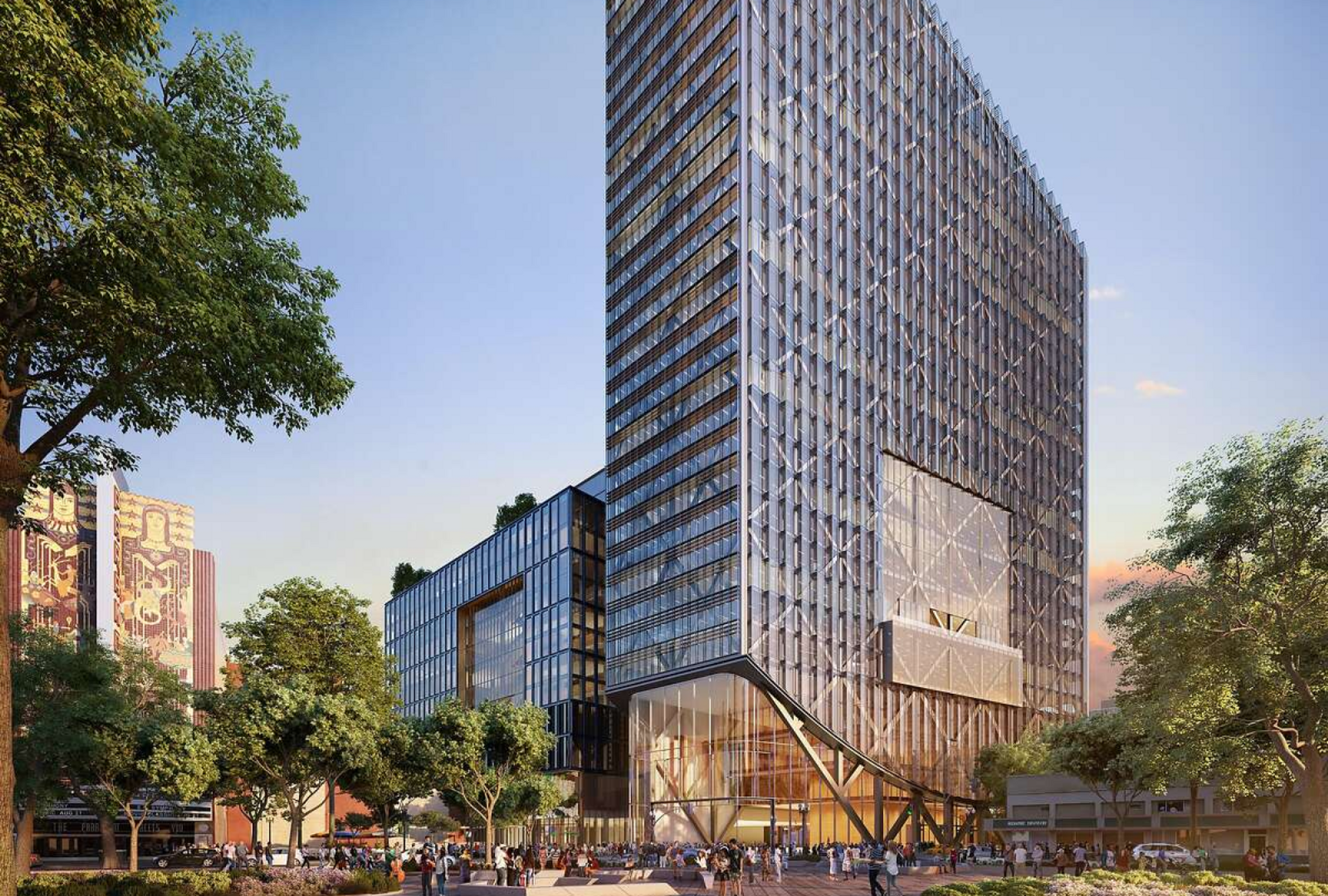
A rendering of the Eastline project
Courtesy of SUDA
How are you financing these developments and what are some of the challenges you have encountered as you’ve worked to fill out the capital stack? Have you been able to find workable solutions for these challenges?
Well, as I mentioned, our projects total about $20 billion in development, so there's always a place for more capital. We've already funded the pre-development of these projects with millions of our own dollars, but we still need more to continue moving forward. I hate to be that broad, but that really is where we are now with a whole range of capital needs.
That means that for us, getting that capital is the holy grail. Unfortunately, this is also one of the biggest things keeping me from participating in this space. And while it’s challenging to access capital in general, it’s exacerbated by what I would say is an unfair lack of access to capital specifically for developers like myself; the projects we have are amazing and very underwritable and my team is very capable, but we just don't have access to pursuit capital and project financing.
That disparity shows up on many different levels. It shows up in subjective underwriting criteria that are evaluated differently. It shows up in the time that it takes to get a deal closed. It shows up the fees and the interest rates that I get charged because of both those things. And then it becomes a self-fulfilling prophecy because of how that all strains your financial condition and creates a death spiral.
One of the secrets I’ll share to help break down those barriers is that government investment can act as de-risking capital. If your project has some public uses and you can get to a point where you have an underwritable bond offering, then you'll find yourself in more of a meritocracy. As long as you check the boxes, properly mitigate the risks, and establish a gradable and insurable transaction, then you'll likely be able to move forward; that makes these types of deals less vulnerable to the subjectivity that may affect a more traditional debt and equity stack.
As you pursue these major developments, are there any specific impacts you hope to make through your work? If so, what are they and how do you measure this impact?
By nature our developments are impact-focused as a function of working closely with the City and State and the size and scale of the projects. We’re talking about tens of thousands of jobs from construction and about 24,000 permanent jobs from the Coliseum project and over 1,000 at Mandela Station. And that’s using a very conservative estimate that assumes three jobs per thousand square feet of commercial space; prior to COVID, the figure was almost double that.
Those new jobs translate directly to new streams of tax revenues for the City, adding to the already significant sales, business, and property taxes that these developments will generate. To give you some sense of that value, our last full economic impact analysis for the Eastline project shows that it will generate about $800 million of net present value over a 30-year period for the General Fund of the City of Oakland.
It’s important to note too that those are just the figures from our impact reports. Another important, but less measurable impact is that we’ve set a gold standard for community engagement that I think other developers of all types of backgrounds are starting to embrace. We make it a point to engage in multiple different formats and forums because we know that if we do that, then the community will come to really fight for the project as our partners and advocates. And the added benefit is that we’ll also get some of our best ideas from those lengthy discussions.
That seems counterintuitive because it’s still widely assumed that community engagement opens the door to demands you may never be able to pay for. However, I truly believe that people just want to be included and involved; if they are, then they’ll want you to be successful and they’ll want your project to be successful as well.

By Ximena Natera for Commonplace
"This whole notion that you have to sacrifice returns and take greater risks in order to be inclusive and equitable is complete BS."
What are your thoughts on the tension between financial returns and impact? How have you seen this tension play out across your body of work?
My hypothesis is that this “tension” only exists because people want to maintain the status quo and we have to work hard to overcome this perception with objective, credible data.
At Thomas Berkley Square, for example, we performed great in terms of project-level returns despite, or rather because of, community engagement. In fact I’d say that project right there is an argument for pursuing projects equitably and inclusively because it helped shave months, if not years, off the entitlement process. We got expedited approvals because we didn't have a bunch of NIMBYs constantly showing up and trying to kill the deal and when they did show up, they were overwhelmed by profound public support. We may have spent an extra two to six months on those critical conversations with the community stakeholders, but that’s far better than being held up for two or three years by activists and then potentially missing the market. You can put dollars to that, you can put holding costs to that, and you can do a present value analysis for that. Then, when you consider other unique tools like tax increment and low-cost public financing, it’s clear that impact can be accretive to value. And that’s just on the return side.
On the risk side, I think people always discount the risks to society of not being equitable and inclusive. To illustrate, one of my colleagues told me recently that they had some folks come to their building to perform due diligence for a potential purchase. This was a nearly fully occupied and beautiful new building in Downtown Oakland. The buyers met, had a nice lunch – you know, great atmosphere, Barry White music in the background and all that. Then, when the prospective buyers got back to their rental cars, they found out that both cars had been broken into and their luggage had been stolen right in the middle of downtown. Even just personally, at this point I’ve had my car windows smashed 11 times now, even with nothing in the car. When I connect the dots, it’s clear to me that this is really a function of not having holistic economic participation and the frustration that comes with excluding people from opportunity. I think the public needs to be better informed about that; even if we’re not pursuing inclusivity and impact out of a sense of being morally right, we should still pursue it because we want to be safe, we want our kids to be safe, and we want a healthier economy that allows more people to participate equitably.
And it's not like you’ve got to take away something from one group to give to another group, either. A lot of people think that impact means like, out of 100 cranes you need to take 20 of them away from one group and redistribute them to people of color. No. The way I see it is: if we had a functioning economy with broader participation, we would have a need for 400 cranes in the skyline – and I’d get my fair share by simply meeting market demand, without taking a single thing away from the people who have all the cranes today. That bigger and healthier economy all starts with building more equitably and inclusively.
These are the fundamentals that we have to start objectively bringing forward, so I'm excited to be working with research universities, people that have big megaphones, and people like yourself that are looking to help better inform the public. This is about much more than just being morally right. This is about creating a healthier society and ensuring that we all can share in the benefits of the build economy.
"The way I see it is: if we had a functioning economy with broader participation, we would have a need for 400 cranes in the skyline – and I’d get my fair share by simply meeting market demand, without taking a single thing away from the people who have all the cranes today. That bigger and healthier economy all starts with building more equitably and inclusively."
There has been a lot of conversation about the difficulties Black and Brown developers face in accessing capital for their projects, which you’ve already alluded to in this discussion. Could you elaborate on your experiences and share your thoughts on this issue?
Sure. So, for example, on the Eastline project, I’m currently in a partnership with my good friends at Lane Partners, a major developer here in the Bay Area, and together we’re in a JV with Walton Street Capital, the deep-pocketed institutional investor for the project.
Now, rewinding a bit here, prior to Eastline, I had signed a $22.5 million contract giving me control of the old Sears Building here in Oakland. I spent the better part of two years and a couple of million dollars in fees – mostly the profits I received from Thomas Berkeley Square – trying to line up investors to take the site down and move forward. The entire time I got nothing but lectures and people trying to circumvent me and take the property over. It was as if somehow my investment of time and money wasn’t worthy of the same professional consideration and recognition. Long story short, I wasn’t able to get the capital together and ended up having to settle for trading the site for an investment into the Eastline.
Meanwhile, just six days after I released my contract, Lane Partners and Walton Street Capital were able to close on the site – and for $2.5 million more than my contract price, too! 10 months later, they sold it to Uber for $123.5 million, who later sold it to CIM for about $180 million. I think that the site has traded again since, this time for over $400 million to an offshore investor. The difference between me and Lane Partners was that they had access to my mom's pension money and I didn’t. And this is not to criticize them at all – we're good friends and we're working together – but I think it shows demonstratively that there’s a paradigm that’s less than ideal for people like me; it’s reflected in this example as well as many others that I have just like this.
It’s also reflected in the fact that the demographics of who gets to build the city is not representative at all of the people who live in the city. In a city that's over 60% people of color, there has been minimal African American participation in the hundreds of billions of dollars of development that has taken place in Downtown Oakland. Out of all the new buildings in the skyline, our project, Thomas Berkley Square – almost 15 years later – is still the only one that was presided over by an African American development firm. Somehow, we were an early mover that helped establish the area’s economic viability, yet we haven’t been able to participate in its boom since.
The funny thing is that we’re often looked at as “emerging developers.” However, SUDA had already completed the first phase of Thomas Berkley Square by the time Lane Partners was founded in 2006. So my question is: what emerging program did Lane go through? Because I would love to sign up for that one. Of course, they’re exceptional and extremely capable developers, but they also have access to capital that developers of color who are even better qualified than me don’t have. Those developers may be just as exceptional and just as capable as Lane, but they aren’t building the skyline either – they would like to, they just don’t have the resources to do it.
"When you deny entire communities the ability to participate in the recycling of those pension dollars, you take away their means of wealth creation and their ability to be self-sufficient. In Oakland, that means that there are few opportunities for economic mobility and that a huge portion of the population is excluded from participating in the economic engine entirely. Therefore, it’s no wonder that our homeless camps are now growing faster than our skyline."
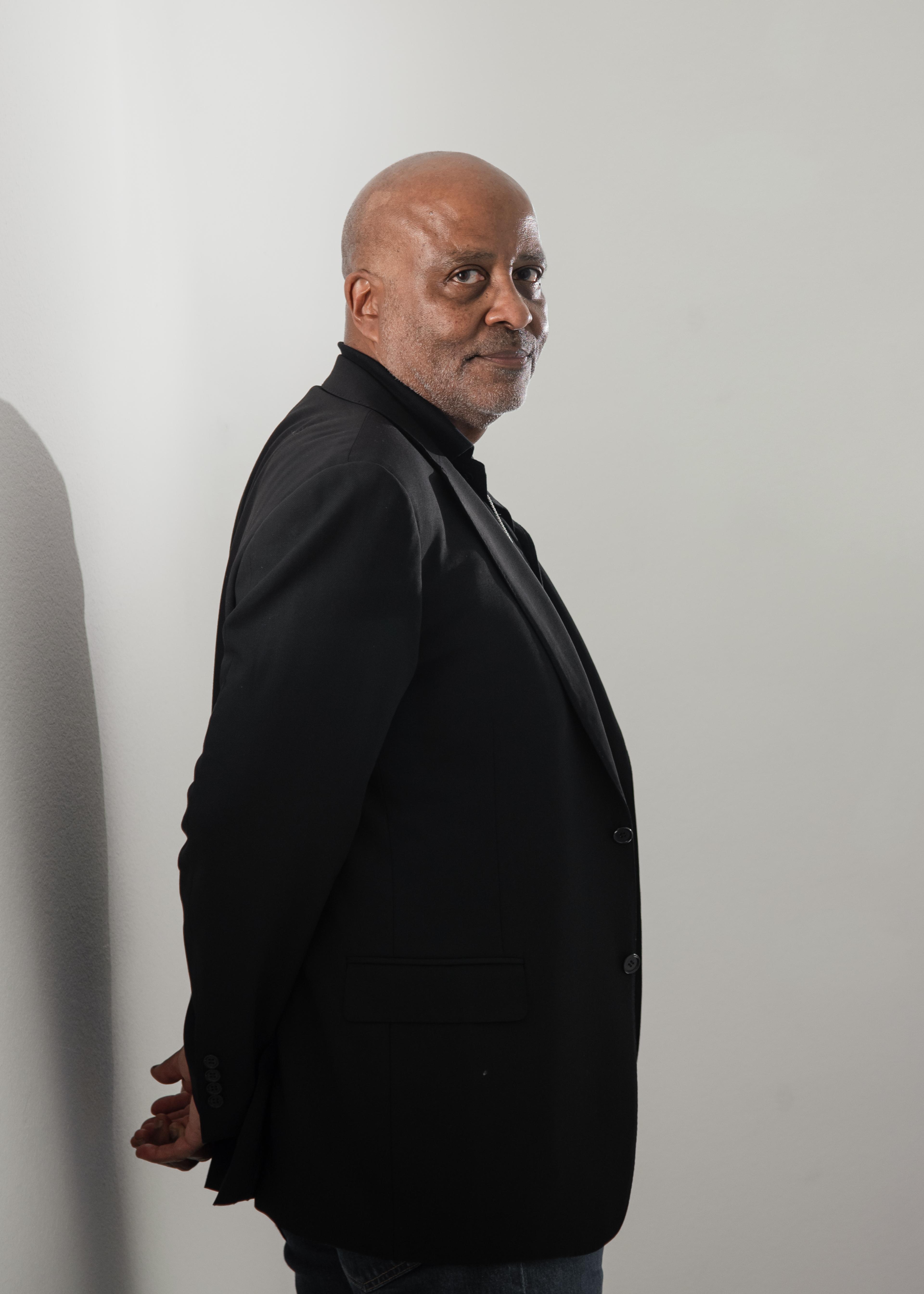
By Ximena Natera for Commonplace
What drives you and motivates you to do what you do?
The way I see it, I have no choice. I come from a family and background that has given me amazing opportunities that I believe are also profound responsibilities. The baton has been passed to me and my generation and I'm passing it to the next generations to run with it; it’s about incremental improvement at every step in this journey to freedom and equality.
Today, we're not getting fire hoses and dogs turned on us like we were back in the 60s and 70s, but the front lines are now about access to capital and, more specifically, to our own capital and contributions. My mom contributed to her pension fund – every two weeks for 40 years, just like a lot of people – but my dad, and many developers of color like him, never had the chance to utilize those invested funds for his projects. My parents never really connected those dots, but I have and I know two things: I know that the people building Oakland today have my mom's pension money and I know that I don't.
That’s given me a perspective that I feel I need to bring to the people’s attention, so they can understand how important access is – and not only for people of color, but for everyone. When you deny entire communities the ability to participate in the recycling of those pension dollars, you take away their means of wealth creation and their ability to be self-sufficient. In Oakland, that means that there are few opportunities for economic mobility and that a huge portion of the population is excluded from participating in the economic engine entirely. Therefore, it’s no wonder that our homeless camps are now growing faster than our skyline.
Eventually, those issues begin to have real implications for project economics. For example, there is a new luxury residential building here that recently had ten of its windows shot out, which took them five months to replace because the cranes had already left the site. That building’s pro forma underwrote rent at $63 per square foot annually – do you think the people living there today will renew their very expensive leases when their windows are getting shot out and their cars are being broken into? When there are people crapping on their front porch? And even if they do choose to renew, do you think they would accept higher rents or would they demand more concessions?
To me, all of this is a clear sign that the general level of frustration among economically-excluded populations is starting to boil over – and it’s getting to the point where even the pension fund investments are being put at increasing risk. If we don't start addressing these social issues and pursuing a more equitable model of economic development, there will only be increasing costs going forward for everyone, regardless of race, gender, or anything else.
What legacy do you hope to leave?
By the time we are finished with our projects, our legacy will include close to 20 million square feet of development built in a very inclusive and equitable manner. However, that doesn’t mean that it'll be built entirely by black people or entirely by white people; it's going to be built by a community of people that closely represents the demographics of this region, including the people that have been displaced.
In pursuing that approach, we're going to leave behind well-performing assets that contribute to a healthier economy and a development model, proven through projects like Thomas Berkeley Square, that can be extended to benefit a bigger, broader cross section of America.

Alan Dones
Strategic Urban Development Alliance
